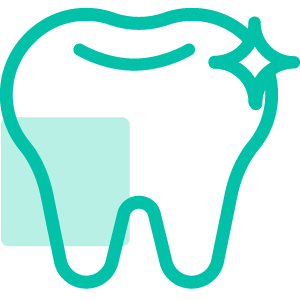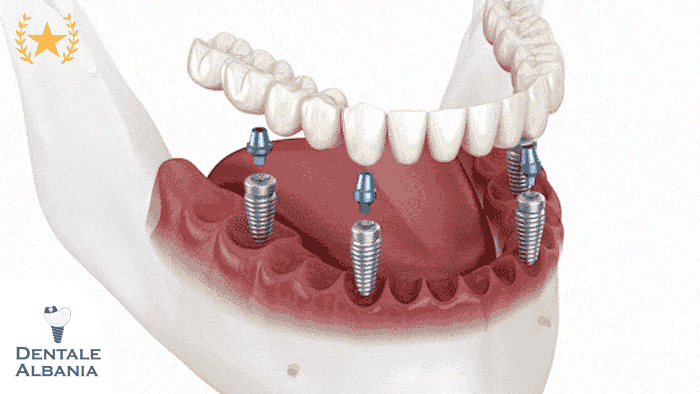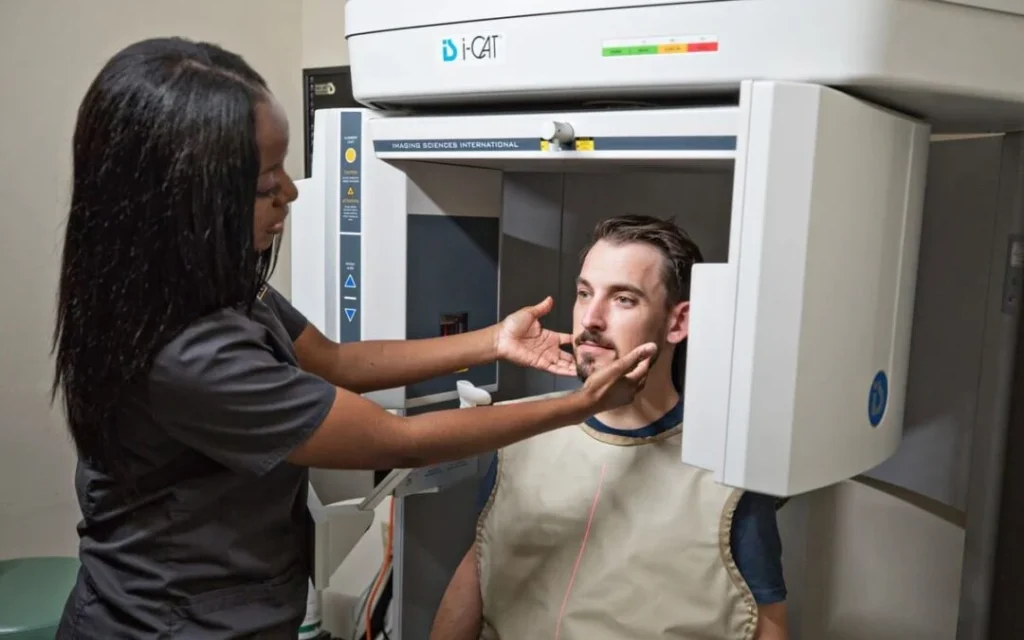What Is a Cbct scan dental and How Does It Work?
Cone Beam Computed Tomography (CBCT) has transformed dental diagnostics, offering an advanced imaging solution that provides high-resolution, three-dimensional images of a patient’s teeth, jawbone, and surrounding structures. Unlike traditional dental scans, which capture only two-dimensional images, a CBCT scan dental provides a more detailed view, making it a crucial tool in modern computed tomography in dentistry.
CBCT technology is widely used in dental CBCT scanning because it enables precise assessments for treatments such as dental implants, orthodontics, and oral surgery. The CBCT scanner emits a cone beam computed tomography X-ray that rotates around the patient’s head, capturing multiple images from different angles. These images are then compiled by a specialized software program to create a comprehensive 3D CBCT scan of the oral and maxillofacial region.
What Is CBCT in Dentistry?
- CBCT in dentistry is an imaging technique that generates high-resolution 3D images of dental structures, including teeth, bone, soft tissues, and nerve pathways.
- It provides a superior alternative to dental X-rays by offering a detailed view of oral anatomy, crucial for diagnosing complex conditions and treatment planning.
- CBCT imaging is essential for procedures such as dental implant placement, orthodontic evaluations, wisdom tooth extractions, and temporomandibular joint disorder (TMJ) assessments.
What Is a CBCT Scan?
- A CBCT scan dental is a specialized form of X-ray that captures multiple high-resolution images, which are combined into a 3D model of the oral structures.
- Unlike traditional CT scans for teeth, CBCT scans use a cone-shaped X-ray beam, significantly reducing radiation exposure while delivering precise diagnostic imaging.
- The scan is quick and non-invasive, typically lasting 20 to 40 seconds, making it ideal for routine dental assessments and complex surgical procedures.
CBCT technology enhances treatment accuracy by allowing dentists to analyze bone density, locate nerve canals, and assess sinus positioning, ensuring optimal treatment outcomes. Whether you need dental implants, root canal therapy, or orthodontic adjustments, a CBCT dental scan is an invaluable tool for both dentists and patients.
What Is the Difference Between CBCT and Other Imaging Techniques?
CBCT scan dental technology is a major advancement in dental imaging, but how does it compare to other traditional imaging techniques such as CT scans, panoramic X-rays, and intraoral X-rays? Understanding these differences helps patients and professionals choose the best imaging method for specific dental treatments.
What Is the Difference Between a CT Scan and a CBCT Scan?
- A CT scan (Computed Tomography) and a CBCT scan dental both use X-ray technology, but CBCT is designed specifically for dentistry and maxillofacial imaging, whereas CT scans are used for full-body imaging in hospitals.
- CBCT scans use a cone beam that rotates around the head, capturing a highly detailed 3D image of the oral structures in a single scan, while CT scans use fan-shaped beams, requiring multiple scans to create a full 3D image.
- CBCT scan dental imaging provides a more localized, high-resolution image, whereas CT scans are broader and focus on a wider range of tissues.
Is CBCT Cheaper Than CT?
- CBCT scans are generally more affordable than traditional CT scans because they require less equipment and are performed in a dental clinic rather than a hospital.
- The cost of CBCT scans varies based on location, the complexity of the scan, and the clinic. On average, they are cheaper than CT scans, making them a cost-effective choice for dental and maxillofacial evaluations.
- Unlike CT scans, which may require a hospital referral, CBCT scans are easily accessible at specialized dental clinics.
CBCT vs. OPG (Orthopantomogram) and Intraoral X-Rays
- OPG (panoramic X-rays) provide a broad two-dimensional view of the entire mouth, useful for general dental evaluations, but they lack the detailed depth perception of a CBCT scan.
- Intraoral X-rays focus on small sections of the mouth, capturing detailed images of individual teeth, making them useful for cavity detection but not for complex surgical planning.
- CBCT imaging is superior for dental implants, bone grafting, sinus lifts, and orthodontic planning because it provides a precise 3D view of bone structures, nerves, and soft tissues.
Compared to traditional dental scans, CBCT scan dental technology offers higher accuracy, lower radiation exposure, and improved diagnostic capabilities. Its ability to capture detailed 3D images in a single scan makes it the preferred choice for advanced dental procedures such as implants, TMJ evaluation, and complex extractions.
Why Do You Need a CBCT Scan in Dentistry?
A CBCT scan dental has become an essential component of modern dentistry, significantly enhancing a dentist’s ability to accurately diagnose and effectively treat a wide range of dental conditions. While traditional dental imaging methods such as panoramic X-rays (OPG) or conventional intraoral X-rays are sufficient for basic dental assessments, there are many scenarios in which the detailed, three-dimensional imagery provided by a CBCT scan is indispensable.
One of the most common reasons for utilizing a CBCT scan dental procedure is the planning and execution of dental implants. A successful dental implant requires precise measurement and evaluation of jawbone quality, density, and positioning relative to critical anatomical structures such as nerve canals and sinus cavities. The high-resolution images from a CBCT scan ensure accurate and safe implant placement, reducing risks such as nerve damage or sinus perforation, which are potential complications with less detailed imaging.
Additionally, CBCT scans are invaluable for complex orthodontic cases. When planning orthodontic treatments, such as braces or clear aligners, dentists rely on precise anatomical measurements and assessments. CBCT technology allows dentists and orthodontists to evaluate the jawbone structure, tooth orientation, and bite alignment thoroughly. This comprehensive perspective ensures treatment plans are tailored accurately to the patient’s unique oral anatomy, resulting in more predictable outcomes.
Another vital application of CBCT scans is in diagnosing conditions involving impacted or displaced teeth. Impacted wisdom teeth, for example, can pose significant challenges during removal due to their proximity to nerve structures. CBCT scans provide detailed visualization of tooth position, root structure, and nerve pathways, allowing oral surgeons to minimize complications during surgical extraction.
Moreover, a CBCT scan dental procedure is critical for evaluating potential root canal treatments. It helps in identifying root fractures, root canal anatomy complexities, and infections. Traditional X-rays often miss subtle details due to their two-dimensional nature, but the three-dimensional images from a CBCT scan provide a clear picture, ensuring that root canal procedures are completed safely and efficiently.
Lastly, CBCT scans are highly beneficial for diagnosing and managing Temporomandibular Joint Disorder (TMJ), allowing dentists to visualize joint alignment and bone structure. This facilitates targeted treatments that address the underlying cause rather than merely alleviating symptoms.
In summary, the depth and clarity offered by a CBCT scan dental imaging technique significantly enhance diagnostic capabilities, elevate patient safety, and improve treatment outcomes across numerous dental procedures. It is a crucial tool in providing modern, patient-centered dental care.
How Is CBCT Used for Dental Implant Treatment?
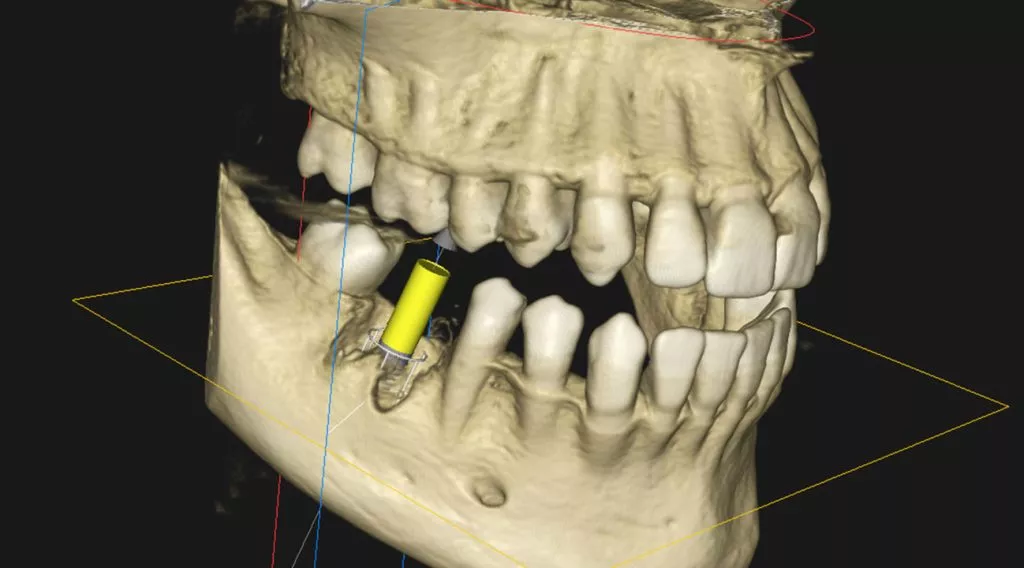
Dental implants have revolutionized modern dentistry, offering patients a permanent solution for missing teeth. However, the success and safety of dental implants greatly depend on precise planning and accurate placement. This is where CBCT scan dental imaging becomes an essential part of the treatment process, significantly enhancing outcomes.
Why Are CBCT Scans Used for Dental Implants?
When planning dental implant procedures, accurate assessment of jawbone quality, bone density, and anatomical structures is crucial. Traditional dental scans and two-dimensional X-rays cannot reliably measure these critical aspects, increasing the risk of complications during surgery. A CBCT scan dental provides detailed, three-dimensional images that clearly illustrate the bone’s width, height, and density. This allows dentists to:
- Precisely determine the optimal location for implants, ensuring adequate bone support.
- Accurately assess proximity to critical structures such as nerve canals, blood vessels, and maxillary sinus cavities, significantly reducing the risk of nerve damage and sinus complications.
- Identify whether additional procedures, such as bone grafting or sinus lifts, are necessary prior to implant placement.
How Accurate Is CBCT for Dental Implants?
CBCT scans are highly accurate, typically offering precision within fractions of millimeters. This high degree of accuracy is essential when planning and executing dental implant procedures. Unlike standard two-dimensional dental X-rays, CBCT images provide complete visual data from every angle, giving dentists comprehensive anatomical insights into the patient’s jaw structure.
- Improved Surgical Precision: CBCT scans enable dentists to digitally plan implant placement, virtually simulating the surgical procedure before it happens, which increases procedural accuracy and patient safety.
- Reduced Surgical Risks: By clearly visualizing anatomical landmarks, CBCT significantly lowers risks associated with dental implant surgery, such as inadvertent nerve injury or incorrect implant placement.
- Better Patient Outcomes: High-resolution 3D imaging allows for customized implant solutions tailored to each patient’s unique anatomy, enhancing both aesthetic and functional results.
Moreover, CBCT scans facilitate effective communication between dental professionals and their patients. The detailed images obtained allow dentists to visually demonstrate to patients the specific condition of their jawbone, the positioning of their implants, and why certain additional procedures might be necessary. This clarity ensures informed decision-making, enhanced patient trust, and overall satisfaction with the treatment.
In summary, using CBCT scan dental technology for dental implants significantly improves treatment accuracy, patient safety, and long-term success. Its precision, reduced radiation exposure compared to traditional CT scans, and detailed anatomical visualization make it indispensable in modern implant dentistry.
What Happens During a CBCT Scan?
A CBCT scan dental procedure is designed to be both quick and comfortable, providing valuable three-dimensional images of the teeth, jawbone, and surrounding structures. This detailed view allows dentists to diagnose and plan treatments accurately, whether it’s for orthodontics, dental implants, or root canal therapy. Knowing what to expect can help ease any concerns a patient might have before undergoing the scan.
How Long Does a Dental CBCT Scan Take?
- The scanning process typically lasts between 20 to 40 seconds, although this can vary based on whether you need a full mouth scan or a more localized image.
- The brief scan time not only reduces potential discomfort but also limits patient movement, which ensures crisp, clear images.
- By contrast, more traditional forms of imaging—like multiple intraoral X-rays—may take longer and still not offer the same level of detail.
What to Expect When You Get a CBCT Scan?
- Pre-scan Preparation: Patients are generally asked to remove any metal objects, such as jewelry, hairpins, or dentures, as these can interfere with the X-ray beams and produce artifacts in the image.
- Positioning and Scanning: You will either sit or stand in a comfortable position while the CBCT scanner rotates around your head. Because the cone beam captures the entire region in one pass, you typically only need to remain still for a short period.
- Radiation Safety: Compared to traditional CT scans, CBCT scans use a cone-shaped beam and lower radiation dosage, focusing specifically on the dental and maxillofacial region. This targeted approach is safer while still delivering highly detailed images.
- Immediate Results: Once the scan is complete, the imaging software reconstructs a 3D model of your oral structures. These detailed images allow your dentist to evaluate everything from nerve pathways and sinus cavities to bone quality and tooth positioning.
Overall, a CBCT scan dental procedure is an invaluable diagnostic and planning tool, offering enhanced accuracy and comprehensive information for a range of treatments. Because of its speed, simplicity, and clarity, patients can feel confident knowing they are receiving advanced, precise dental care.
CBCT Safety, Risks, and Radiation Exposure
One of the most common concerns regarding CBCT scan dental procedures is radiation exposure. While CBCT scans do use X-ray technology, they are designed to deliver lower radiation doses compared to traditional medical CT scans, making them a safe and effective diagnostic tool in dentistry. Understanding the benefits, risks, and safety measures of CBCT scans can help patients make informed decisions about their dental care.
Are CBCT Scans Safe?
- Low Radiation Exposure: CBCT scans emit significantly less radiation than traditional CT scans, making them a safer alternative for dental imaging.
- Targeted Imaging: Unlike conventional CT scans, which expose the entire body to radiation, CBCT scan dental imaging focuses only on the oral and maxillofacial region, minimizing unnecessary exposure.
- Quick Scanning Time: The rapid scan duration (typically 20-40 seconds) reduces the amount of radiation absorbed by the body.
- Modern Technology Enhancements: Advances in CBCT technology continue to reduce radiation doses, making it a safe option for both adults and children when used appropriately.
Does a CBCT Scan Show an Infection?
- Detection of Dental Infections: CBCT scans are highly effective in identifying dental abscesses, periodontal infections, and bone infections, which may not always be visible on standard dental X-rays.
- Precise Localization of Infection: The three-dimensional imaging allows dentists to assess the extent of the infection, its impact on surrounding structures, and the best course of treatment.
- Monitoring Treatment Success: CBCT scans can be used to track healing after root canal therapy or surgical interventions to ensure infections have fully resolved.
What Are the Disadvantages of CBCT in Dentistry?
While CBCT scans offer unparalleled imaging accuracy, there are a few drawbacks to consider:
- Higher Cost Compared to Traditional X-Rays: CBCT scans are more expensive than conventional panoramic (OPG) or intraoral X-rays, although they provide far more detailed information.
- Not Always Necessary for Routine Procedures: While CBCT scans are invaluable for dental implants, orthodontics, and oral surgery, they may not always be required for basic dental checkups.
- Limited Soft Tissue Visualization: CBCT scans primarily focus on bone and dental structures and do not provide detailed images of soft tissues like gums or muscles.
Despite these limitations, the benefits of CBCT scan dental imaging far outweigh the risks, especially when used for complex dental treatments. By offering detailed, three-dimensional imaging with minimal radiation exposure, CBCT technology continues to be a valuable asset in modern dentistry.
Cost of CBCT Scans
One of the most common questions patients ask about CBCT scan dental procedures is regarding the cost. While CBCT scans offer highly detailed 3D imaging that enhances diagnostic accuracy and treatment planning, their cost varies depending on several factors, including location, clinic, and the complexity of the scan required.
How Much Does a CBCT Scan Cost?
- The cost of a CBCT scan can range anywhere from $150 to $600, depending on the type of scan required and the dental clinic’s pricing structure.
- Full-mouth CBCT scans tend to cost more than localized scans, which focus on specific areas such as a single tooth, sinus, or jaw section.
- Prices may also vary depending on whether the scan is performed in a private dental clinic or a hospital setting.
How Much Is a CBCT Full Mouth Scan?
- A full-mouth CBCT scan typically ranges between $250 and $600, as it captures a comprehensive view of the entire maxillofacial region.
- This type of scan is often necessary for orthodontic planning, full-mouth dental implant placement, or advanced periodontal assessments.
- While full-mouth CBCT scans cost more than traditional panoramic X-rays, they provide far greater diagnostic accuracy, reducing the likelihood of complications.
How Much Is a CBCT Scan in the UK?
- In the United Kingdom, a CBCT scan can range from £100 to £400, with full-mouth scans being on the higher end of the spectrum.
- NHS coverage for CBCT scans is generally limited, meaning most patients pay out-of-pocket or have the procedure done through private clinics.
- The cost of a CBCT scan in the UK depends on factors such as clinic location, dentist expertise, and whether additional imaging analysis is required.
Although CBCT scan dental procedures can be more expensive than traditional dental X-rays, they offer superior precision and diagnostic capabilities, ultimately leading to better treatment outcomes. Investing in a CBCT scan ensures higher accuracy in procedures like dental implants, root canals, and orthodontic planning, reducing the risk of complications and the need for additional treatments.
How Much Is a CBCT Scan in Albania?
In Albania, the cost of a CBCT scan dental typically ranges from €50 to €120, depending on the type and complexity of the scan:
-
A localized CBCT scan (for a single tooth or a small area) usually costs around €50 to €80.
-
A full-mouth CBCT scan (covering the entire jaw or both arches) may cost between €90 to €120.
-
Prices can vary slightly depending on the clinic, city, and whether radiological interpretation is included.
Compared to prices in the UK or EU countries, CBCT scans in Albania are significantly more affordable, making it a cost-effective option for both local and dental tourism patients seeking high-quality diagnostics.
Frequently Asked Questions About CBCT Scan Dental
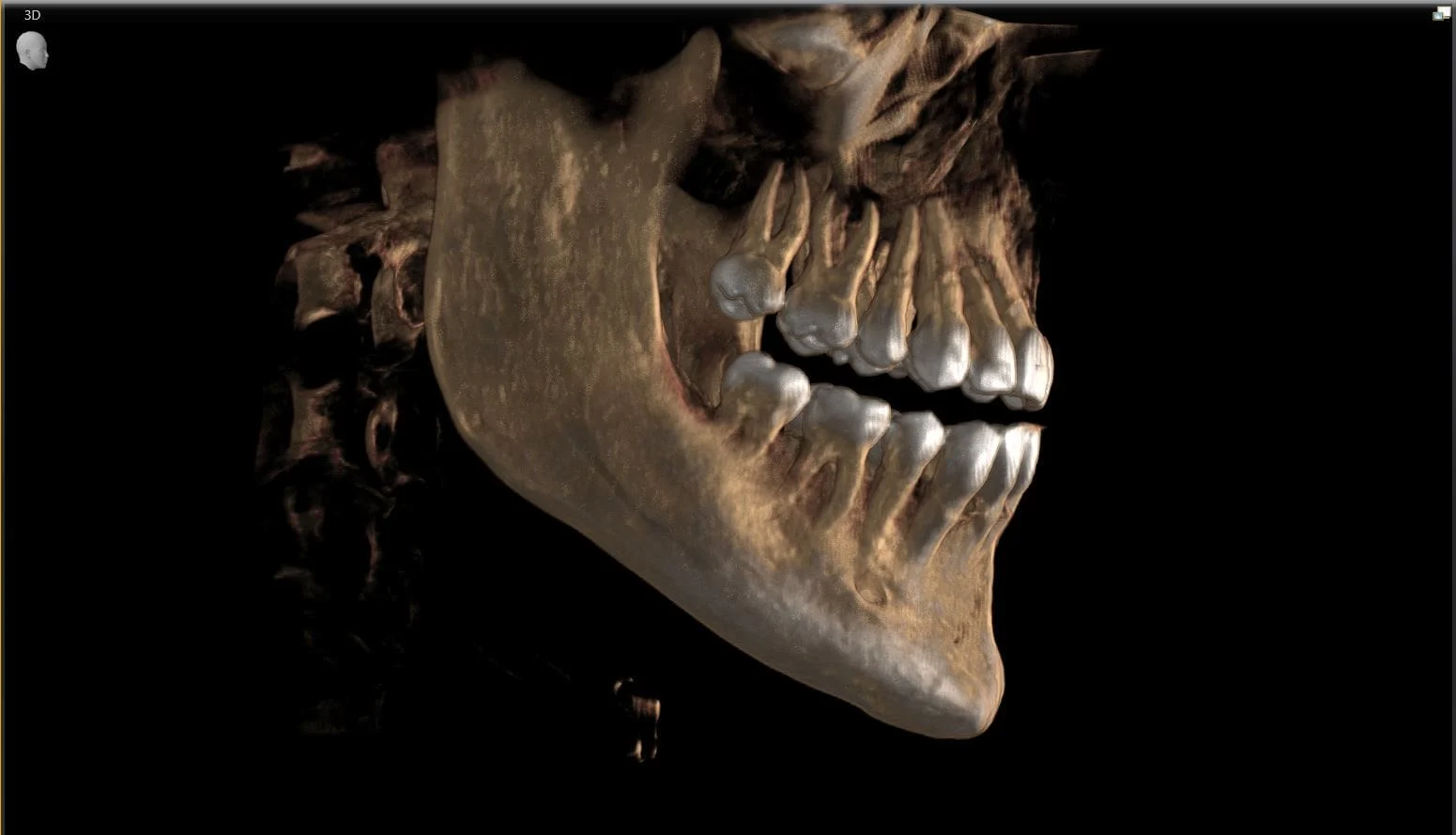
Is CBCT Scan Necessary for Dental Implants?
Yes, a CBCT scan dental is often necessary for dental implants, as it provides detailed 3D images of the jawbone, allowing dentists to accurately assess bone density, nerve positioning, and sinus proximity. Here’s why a CBCT scan is crucial for implant placement:
- Bone Structure Evaluation: Ensures that the jawbone has sufficient volume and density to support an implant.
- Precision Implant Planning: CBCT scans help determine the optimal implant location, minimizing the risk of nerve damage or sinus complications.
- Reduced Surgical Risks: With a clear 3D visualization of the oral anatomy, dentists can plan minimally invasive procedures, leading to faster recovery times and better implant success rates.
- Detection of Underlying Issues: CBCT scans can reveal hidden dental infections, bone defects, or abnormalities that could affect the implant’s success.
Although CBCT scans may not be required for every implant case, they are highly recommended for complex cases, including patients with previous bone loss, multiple missing teeth, or sinus-related concerns.
Can CBCT Detect a Cracked Tooth?
Yes, CBCT scan dental imaging is an excellent tool for detecting cracked teeth, especially when traditional X-rays fail to reveal the fracture. Here’s how CBCT scans help in diagnosing cracked teeth:
- High-Resolution 3D Imaging: Unlike standard 2D dental X-rays, CBCT scans offer multiple angles and a cross-sectional view of the tooth, making it easier to detect minor cracks.
- Locating Fracture Lines: CBCT scans provide detailed visualization of the tooth’s internal structure, allowing dentists to pinpoint the exact location and depth of a crack.
- Assessing Surrounding Damage: A CBCT scan can also evaluate whether the crack extends into the root or has caused damage to the surrounding bone or nerves.
- Improved Treatment Planning: Early detection of cracks allows dentists to choose the most effective treatment, whether it’s bonding, a dental crown, root canal therapy, or extraction.
In cases where a patient experiences unexplained tooth pain or sensitivity, but standard X-rays show no visible issues, a CBCT scan can provide the necessary clarity and precision for an accurate diagnosis.


